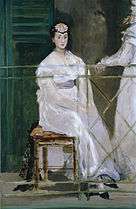The Balcony (painting)
 | |
| Artist | Édouard Manet |
|---|---|
| Year | 1868 |
| Medium | Oil on canvas |
| Dimensions | 170 cm × 124 cm (67 in × 49 in) |
| Location | Musée d'Orsay, Paris |
The Balcony (French: Le balcon) is an 1868 oil painting by the French painter Édouard Manet and was exhibited at the Paris Salon of 1869. The painting depicts four figures. On the left is Berthe Morisot, who became in 1874 the wife of Manet's brother, Eugène. In the centre is the painter Jean Baptiste Antoine Guillemet. On the right is Fanny Claus, a violinist. The fourth figure, partially obscured in the interior's background, is possibly Leon Leenhoff, Manet's son.[1] The painting was sold by Gustave Caillebotte in 1884 and is currently kept at the Musée d'Orsay, in Paris.
Inspiration and description
The painting, inspired by The Majas at the balcony by Francisco Goya, was created at the same time and with the same purpose as The Lunch in the workshop. The three characters, who were all friends of Manet, seem to be disconnected from each other: while Berthe Morisot, on the left, looks like a romantic and inaccessible heroine, the young violinist Fanny Claus and the painter Antoine Guillemet seem to display indifference. The boy in the background is Manet's son, Léon. Just behind the railings, there are a hydrangea and a dog with a ball.[2]
A preparatory study for The Balcony, The Portrait of Mademoiselle Claus, resides in the Ashmolean Museum in Oxford. The portrait’s subject is Fanny Claus, the closest friend of Manet’s wife Suzanne Leenhoff. This unfinished portrait was painted as a study for the finished canvas. Following Manet’s premature death in 1883, the portrait was bought in a studio sale by the great artist John Singer Sargent. The portrait had only been seen once in public since it was first painted in 1868, but in 2012 the Ashmolean Museum succeeded in raising the funds to acquire it and keep it permanently in a public collection in the United Kingdom.[3]
Reception
The aggressive and bold green of the balcony also drew much attention, as evidenced by the article devoted to the work by the Grand dictionnaire universel du XIXe siècle in 1878 which stated:[4] "This painting was exhibited at the Salon of 1869 and is one of those who contributed to form this reputation for eccentricity realistic, this reputation of bad taste that was attached to Mr. Manet." The press considered the painting as "discordant". The contrast of colors (the background completely black, the white faces and clothes, the blue tie of the man, and the green railings) contributes to create an atmosphere of "mystery".[2]
 Detail
Detail The Majas at the balcony, by Francisco Goya
The Majas at the balcony, by Francisco Goya Portrait of Mademoiselle Claus, by Édouard Manet
Portrait of Mademoiselle Claus, by Édouard Manet
References
- ↑ "Manet's The Balcony". Smarthistory. Retrieved 18 July 2012.
- 1 2 Ramos, Julie (1998). L'ABCdaire de Manet (in French). Paris: Flammarion. pp. 34, 35. ISBN 978-2-08-012582-8.
- ↑ http://www.ox.ac.uk/media/news_stories/2012/120808.html
- ↑ Tome XVI, p. 281
External links
- Impressionism : a centenary exhibition, the Metropolitan Museum of Art, December 12, 1974-February 10, 1975, fully digitized text from The Metropolitan Museum of Art libraries

